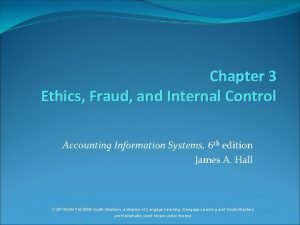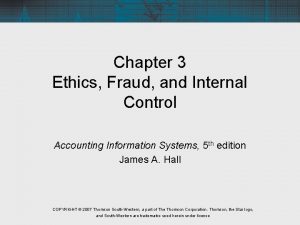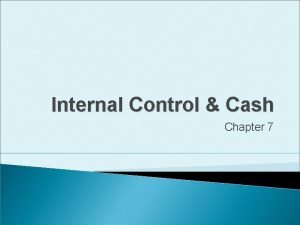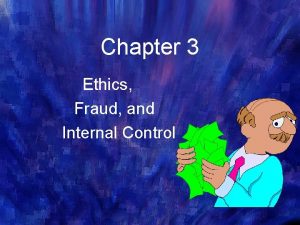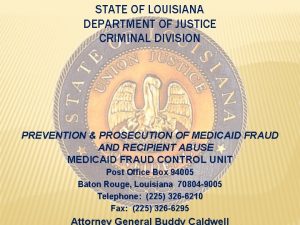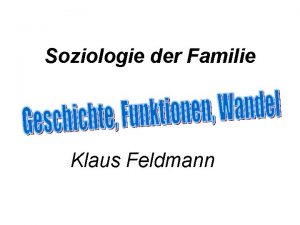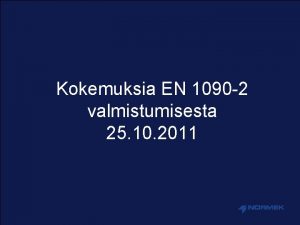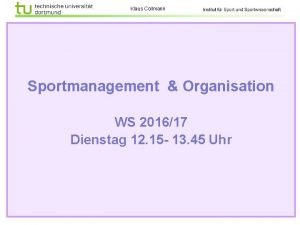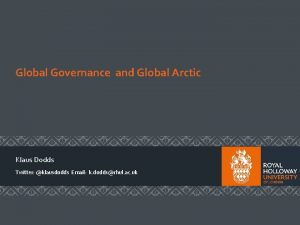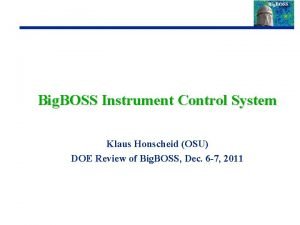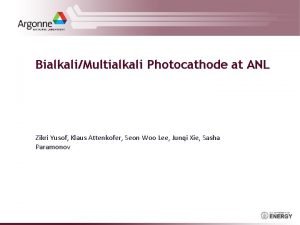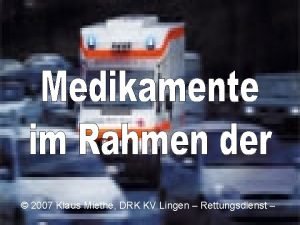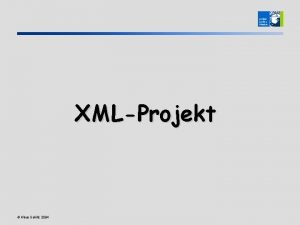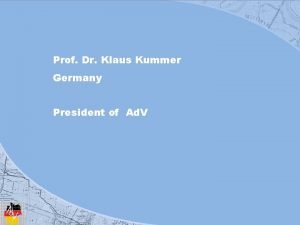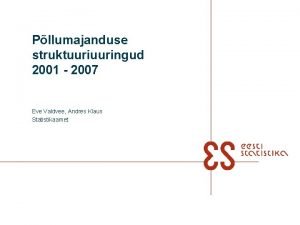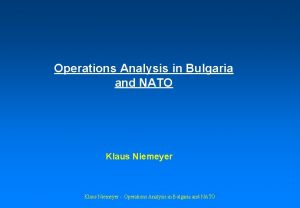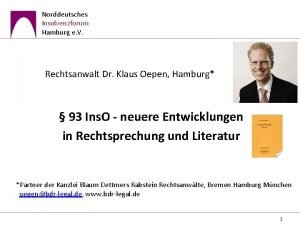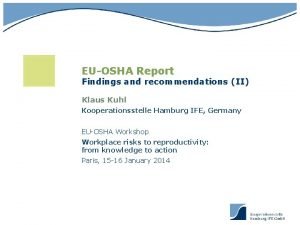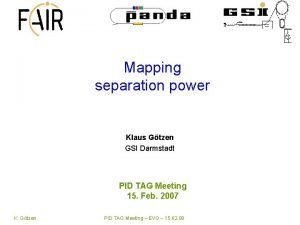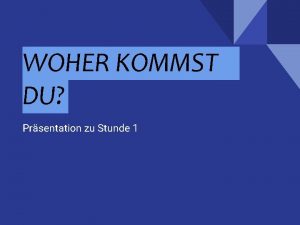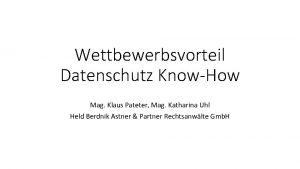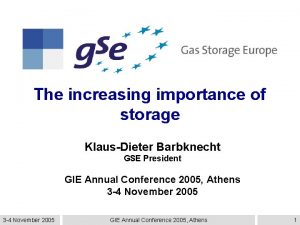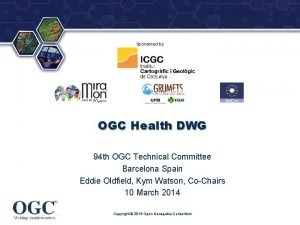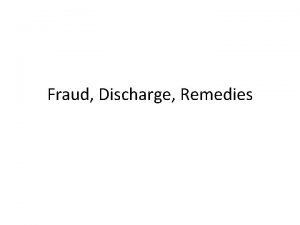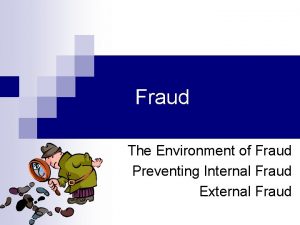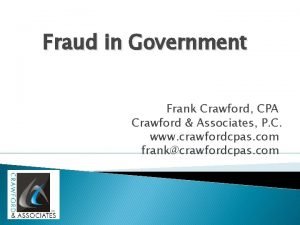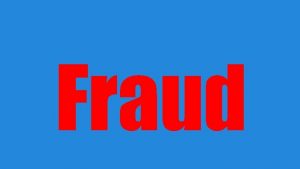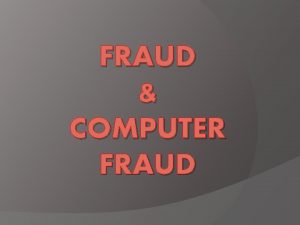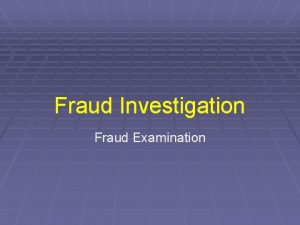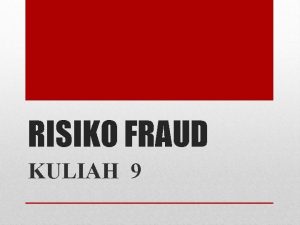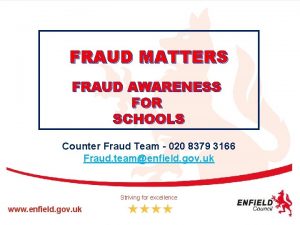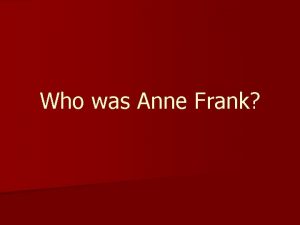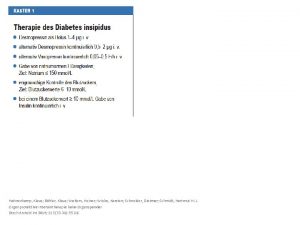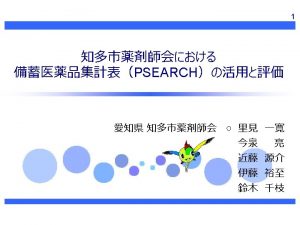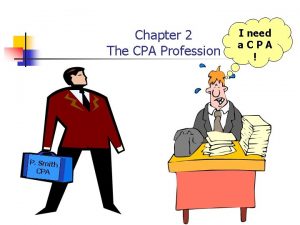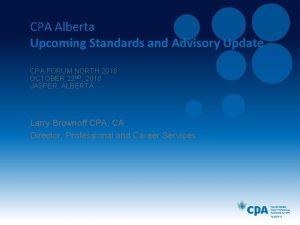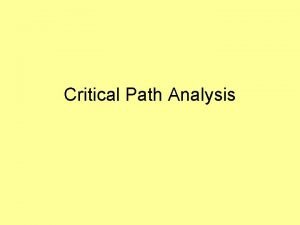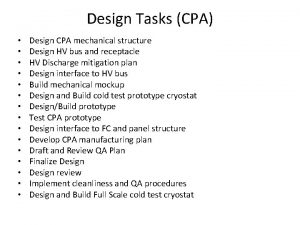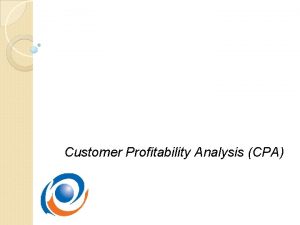Fraud Internal Control Frank M Klaus CPA Fraud







































- Slides: 39

Fraud & Internal Control Frank M. Klaus, CPA

Fraud Definition � Fraud is the misappropriation of assets for the benefit of an individual. � “Willful misrepresentation by one person of a fact inflicting damage on another person. ” � “Any act involving the use of deception to obtain an illegal advantage. ” ISACA

Fraud in operations. � Association of Certified Fraud Examiners � 2006 Report to the Nation on Occupational Fraud and Abuse � The median government and not-for-profit frauds were around $100, 000.

SAS No. 55 � “Fraud is an intentional act the results in a material misstatement in financial statements that are the subject of an audit. ”

SAS No. 82 � “Consideration of Fraud in a Financial Statement Audit” � Adopted in 1997 � Purpose: To clarify the auditor’s responsibility to detect fraud. � Revised as SAS No. 99

SAS No. 99 � Effective � Same � Time December 2002 title as SAS No, . 82 period of: � Post Enron � SOX 2002

SAS No. 99 (Continued) � Issued in response to the past ineffectiveness of risk assessment process during audit. � Requires auditor to gauge the exposure of the entity to the risk of fraud. � “Brainstorming” requirement.

What does fraud include? � Fraud includes: � Balance � Theft Sheet Misstatement of Assets

The Fraud Triangle � The three elements required for FRAUD:

The three side of the FRAUD triangle. � 1. Opportunity � 2. Rationalization � 3. Pressure

Internal Control Issues � The importance of good policies and procedures. � Communicate � Publish � Update

Segregation of Duties � The importance of “segregation of duties” to the internal control process.

Yellow Book � The role of the “Yellow Book” in the internal control process. � The role of the government auditor. importance of review and approval by supervisors.

Yellow Book Update � Government Auditing Standards � GAGAS: Generally Accepted Government Auditing Standards � Provides a framework for conducting high quality audits with competence, integrity, objectivity, and independence.

2007 Yellow Book � Current Edition � Superseded by the 2011 Yellow Book

2011 Yellow Book � Effective for financial audits and attestation engagements for periods ending on or after December 15, 2012, � And for performance audits beginning on or after December 15, 2011. � Early implementation is not permitted.

Resources � Electronic � GAO’s version of document available. Yellow Book Web Page � http: //www. gao. gov/yellowbook � Not subject to copyright protection.

The Role of the Client. � The client has a responsibility to: � Cooperate � Keep with the auditor informed of status updates. � Participate in activities such as � Flowcharting � Narratives

The Client Conference � The final conference is in addition communication during the audit process. � Client � Who sign-off at the conclusion of the audit. should attend the final conference? � Follow-up, � Timing if required.

Management’s Responsibility � Set the Proper Tone at the Top of the Organization. � Develop and implement policies and procedures. � Communicate importance and seriousness of issue.

Management’s Responsibility (Cont’d) � Demonstrate � Not by actions just lip service � Importance of ATTITUDE.

COSO Framework � Committee � AAA � AICPA � IIA � IMA � FEI of Sponsoring Organizations

COSO � Formed by Treadway Commission to develop a framework in which organizations could understand improve their internal controls. � In 1992 issued Internal Control—Integrated Framework � Congress mandated controls reporting for public companies in 1992.

COSO Update � 2006: Internal Controls over Financial Reporting— Guidance for Smaller Public Companies � 2007: New auditing standards provide further support for the COSO Standards.

Five Components of COSO � 1. Control environment � Sets the overall controls tone of an organization. � Foundation control. for all other components of internal

Five Components of COSO � 2. Risk Assessment � Entity’s identification and analysis of risks in the achievement of its objectives. � Risks should be identified and managed.

Five Components of COSO � 3. Information and Communication � Relates to the systems and reports that enable management and employees to carry out their objectives.

Five Components of COSO � 4. Control Activities � Processes, � Help Policies, and Procedures ensure that management directives are carried out. � Consist of controls over the process.

Five Components of COSO � 5. Monitoring � Process that oversees internal control performance.

COBIT � Published by the IT Governance Institute. � COBIT: Control Objectives for Information and related Technologies � Provides good practices across a domain and process framework and presents activities in a manageable and logical structure.

Business Orientation of COBIT � The business orientation of COBIT consists of linking business goals to IT goals. � Management Information � Dashboard � Scorecard � Benchmarking

Common Fraud Risk Areas � Sales and Cash Receipts � Purchasing and Cash Disbursements � Payroll � Equipment, Inventory and Anything Not Bolted Down

Antifraud Controls & Programs � 1. Culture � Tone at the Top � Workplace Environment � Hiring & Promotion � Training � Disciplinary Action

Antifraud Controls & Programs � 2, Evaluating Antifraud Processes and Controls � ID Risk � Mitigate Risks � Implement Controls � Monitor Controls

Antifraud Controls & Programs � 3. Oversight � Audit Committee � Inspector General � Internal Auditor � Independent External Auditor � Certified Fraud Examiner

Antifraud Controls & Programs � 4. Miscellaneous � AICPA � ISACA � ACFE � International Standards of Auditing

Conclusion � 1. Fraud can occur in any organization. � 2. Management must set the tone at the top. � 3. Everyone should be cognizant of the organization’s internal control policies and procedures. � 4. Policies and procedures must be monitored and enforced.

Final Thought � “The best fraud is no fraud. ”

Contact Information � Frank M. Klaus, CPA � Cleveland State University � Department of Accounting � 2121 Euclid Avenue � Cleveland, OH 44115 � F. Klaus@csuohio. edu
 Ethics fraud and internal control
Ethics fraud and internal control Fraud, internal control, and cash
Fraud, internal control, and cash Chapter 3 ethics fraud and internal control
Chapter 3 ethics fraud and internal control Chapter 7 fraud internal control and cash
Chapter 7 fraud internal control and cash Chapter 7 fraud internal control and cash
Chapter 7 fraud internal control and cash Chapter 7 fraud internal control and cash
Chapter 7 fraud internal control and cash Ethics fraud and internal control
Ethics fraud and internal control How do fraud symptoms help in detecting fraud
How do fraud symptoms help in detecting fraud Internal control procedure
Internal control procedure Importance of vouching
Importance of vouching Frank william abagnale
Frank william abagnale Louisiana medicaid fraud control unit
Louisiana medicaid fraud control unit Klaus feldmann familie
Klaus feldmann familie Klaus saarikallio
Klaus saarikallio Klaus collmann
Klaus collmann Klaus exclusive twitter
Klaus exclusive twitter Klaus honscheid
Klaus honscheid Klaus attenkofer
Klaus attenkofer Klaus miethe
Klaus miethe Klaus schild
Klaus schild Klaus boonstra
Klaus boonstra Klaus dieter frey
Klaus dieter frey Klaus kummer
Klaus kummer Andres klaus
Andres klaus Klaus niemeyer
Klaus niemeyer Klaus oepen
Klaus oepen Klaus kuhl
Klaus kuhl Klaus hennicke
Klaus hennicke Klaus gotzen
Klaus gotzen Klaus ropin
Klaus ropin Klaus knaack
Klaus knaack Daniel levinson stages
Daniel levinson stages Klaus riedel
Klaus riedel Klaus niemeyer
Klaus niemeyer Klaus woher kommst du
Klaus woher kommst du Klaus pateter
Klaus pateter Becker klaus
Becker klaus Klaus-dieter barbknecht
Klaus-dieter barbknecht Dr behrent
Dr behrent Klaus peter schipper
Klaus peter schipper
